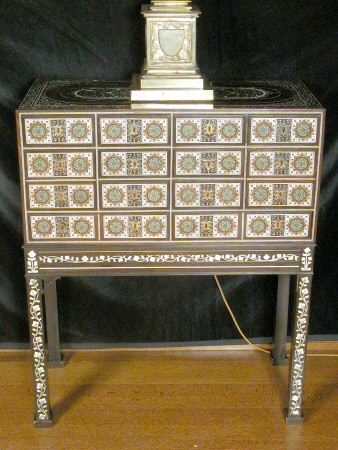Cabinet
Category
Furniture
Date
circa 1680
Materials
Tropical hardwood carcass, rosewood and ebony veneer, inlaid and veneered with ivory and with geometrical patterns of ivory, ebony, sandalwood and exotic woods in sadeli technique, brass mounts; the stand in softwood veneered with ebony inlaid with ivory.
Measurements
370 x 783 x 375 mm
Place of origin
Gujarat (India)
Order this imageCollection
Charlecote Park, Warwickshire
NT 532996.1
Summary
A West Indian cabinet, Sindh or Gujarat, circa 1680, from a pair, veneered in ebony and rosewood inlaid and veneered with sadeli technique of ivory, ebony and exotic woods, of rectangular form it opens with twelve drawers, simulating sixteen, all decorated with geometrical sadeli motifs, similarly inlaid to the top and sides. Each panel has a metal lock plate. Either side as a decorative brass handle. These cabinets are raised on later stands (532996.2) made in England with Vizagapatam inlay to match the suite of chairs (NT 532995.1-10). A pair of Persian cabinets in black ebony, the drawer fronts being decorated with a floral ivory design, cloisonné type medallions. Rectangular ebonised stand with four square legs. Each leg ends in a square plate section. Front legs and front rail are inlaid with ivory in a floral trellis design that mimics that of the chairs.
Provenance
Presented to the National Trust by Sir Montgomerie Fairfax-Lucy (1896 – 1965), two years after the death of his father, Sir Henry Ramsay-Fairfax, 3rd Bt (1870 – 1944), with Charlecote Park and its chief contents, in 1946.
References
Jaffer 2002 : "Luxury goods from India, the art of the Indian cabinet maker", London, V&A publications, 2002. Wainwright, 1989: Clive Wainwright, The romantic interior: the British collector at home, 1750-1850. Studies in British Art. New Haven; London: Paul Mellon Centre for Studies in British Art by Yale University Press, 1989. [Charlecote pp.208-240]
